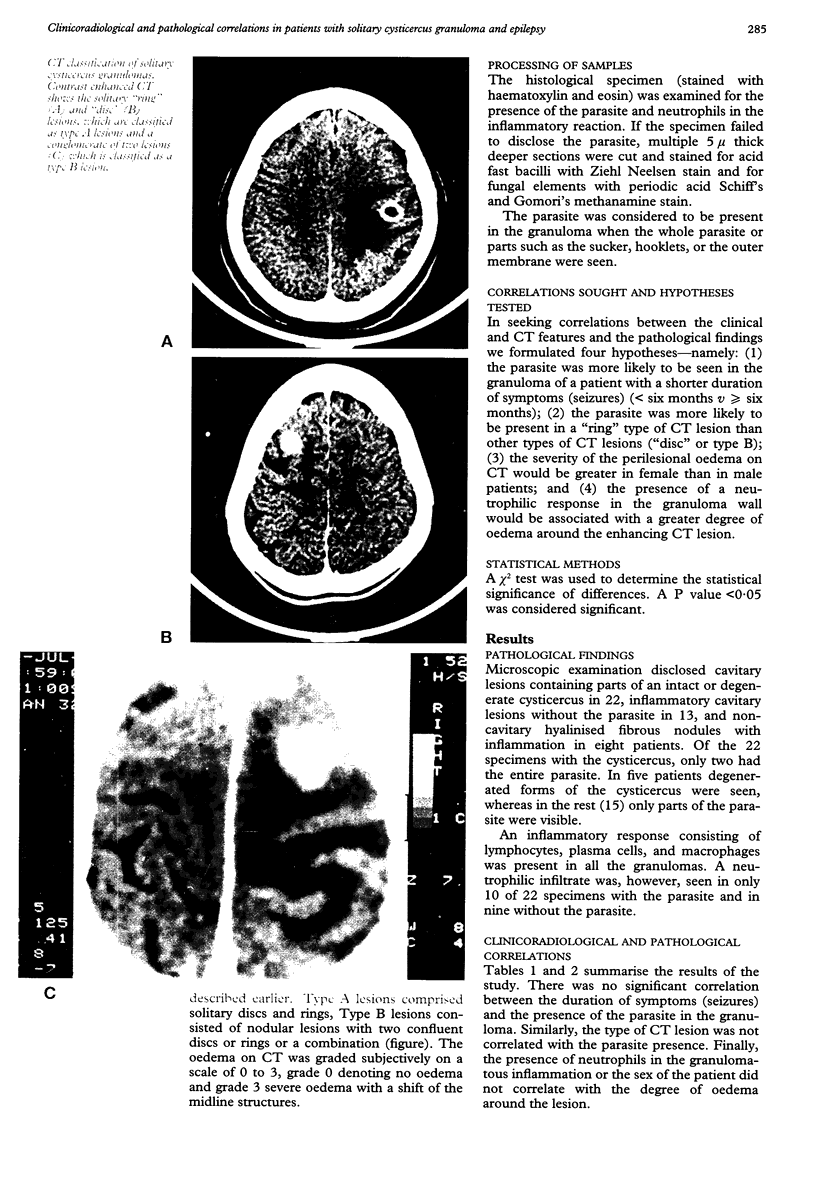Abstract
A study of the clinical, radiological, and pathological correlations in 43 patients with solitary cysticercus granuloma and epilepsy focused on factors that might help in predicting the presence of the parasite in the granuloma and those that might influence the formation of oedema around the granuloma. The duration of symptoms (< six months and > or = six months) and CT morphology of the granuloma (ring and disc, type A; nodular lesion, type B) were studied as factors that could possibly predict the presence of the parasite in the granuloma. The influence of sex of the patient and the presence of a neutrophilic response in the granuloma on the intensity of oedema around the lesion as seen on CT was also studied. The pathological features were studied in the excised granulomas. The intact or degenerated form of the cysticercus was evident in 22 of 43 specimens. Neither the duration of seizures (P = 0.17) nor the type of lesion on CT (P = 0.16) was predictive of the presence of the parasite in the granuloma. The sex of the patient (P = 0.51) and the neutrophilic response in the specimen (P = 0.73) did not correlate with the degree of oedema on CT indicating that neither of these host factors was a major determinant of oedema production. The findings point to the varied and unpredictable natural history of solitary cysticercus granulomas and the complex nature of host-parasite interactions in individual patients. The inability to predict the presence of the parasite in the granuloma on the basis of the clinical or radiological features precludes a selection of patients with such lesions for cysticidal drug treatment.
Full text
PDF


Images in this article
Selected References
These references are in PubMed. This may not be the complete list of references from this article.
- Chandy M. J., Rajshekhar V., Ghosh S., Prakash S., Joseph T., Abraham J., Chandi S. M. Single small enhancing CT lesions in Indian patients with epilepsy: clinical, radiological and pathological considerations. J Neurol Neurosurg Psychiatry. 1991 Aug;54(8):702–705. doi: 10.1136/jnnp.54.8.702. [DOI] [PMC free article] [PubMed] [Google Scholar]
- Del Brutto O. H., García E., Talámas O., Sotelo J. Sex-related severity of inflammation in parenchymal brain cysticercosis. Arch Intern Med. 1988 Mar;148(3):544–546. doi: 10.1001/archinte.148.3.544. [DOI] [PubMed] [Google Scholar]
- Del Brutto O. H., Sotelo J., Aguirre R., Díaz-Calderón E., Alarcón T. A. Albendazole therapy for giant subarachnoid cysticerci. Arch Neurol. 1992 May;49(5):535–538. doi: 10.1001/archneur.1992.00530290123021. [DOI] [PubMed] [Google Scholar]
- Rajshekhar V. Albendazole therapy for persistent, solitary cysticercus granulomas in patients with seizures. Neurology. 1993 Jun;43(6):1238–1240. doi: 10.1212/wnl.43.6.1238. [DOI] [PubMed] [Google Scholar]
- Rajshekhar V., Chandy M. J. Enlarging solitary cysticercus granulomas. J Neurosurg. 1994 May;80(5):840–843. doi: 10.3171/jns.1994.80.5.0840. [DOI] [PubMed] [Google Scholar]
- Rajshekhar V. Etiology and management of single small CT lesions in patients with seizures: understanding a controversy. Acta Neurol Scand. 1991 Dec;84(6):465–470. doi: 10.1111/j.1600-0404.1991.tb04996.x. [DOI] [PubMed] [Google Scholar]
- Rajshekhar V., Haran R. P., Prakash G. S., Chandy M. J. Differentiating solitary small cysticercus granulomas and tuberculomas in patients with epilepsy. Clinical and computerized tomographic criteria. J Neurosurg. 1993 Mar;78(3):402–407. doi: 10.3171/jns.1993.78.3.0402. [DOI] [PubMed] [Google Scholar]



